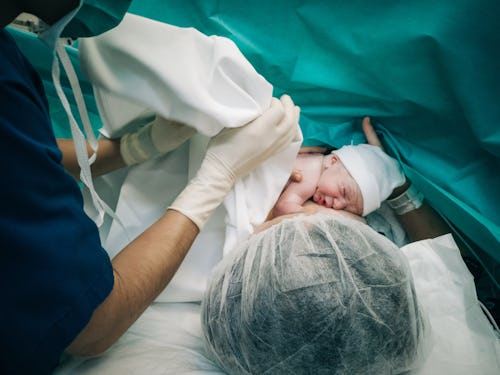
Whether it was scheduled or sudden, delivering your baby via cesarean section is a big deal. It’s a major surgery, after all, and it comes with a whole host of post-op postpartum issues that you’ll need to handle… all the while handling a newborn, too. But what happens when you’re plus size as well? Knowing how to keep a C-section incision dry after surgery (and no matter what your size) is critical to your recovery and your overall health. Here’s how to do it.
How can I keep my C-section incision clean and dry?
When you’re discharged from the hospital after a C-section, your OB-GYN will most likely change your dressings so that you can begin your healing at home. But at some point, you’re going to want to take a shower, and keeping your incision nice and dry is important so it doesn’t become a breeding ground for bacteria. “For the first two weeks use only water to clean your incision,” Dr. Megan Gray, M.D., an OB-GYN at Winnie Palmer, tells Romper. “When you shower, allow the water to hit the incision and run down.”
Use a mild, unscented soap (that doesn’t have beads) to wash the rest of your body. “Use soap on your upper belly but do not scrub over the incision,” advises Gray. “Then rinse your belly off, and pat dry with a clean/dry towel or use the hair dryer on the cold setting to dry your incision.” Once your skin has completely healed, Gray says that you can use your fave soap again; just be mindful to avoid scrubbing with a loofa, because “the area will be numb still and you will be unable to tell how much pressure you are applying and could irritate your skin without knowing it.”
How to keep C-section incision clean and dry when plus size
No matter if you’re plus size or not, you should be extra careful to keep your incision area clean and dry. And the one most effective way to keep the area arid is by wicking away any moisture that might be lingering by your C-section scar. “After showering, lift up your stomach and pat the area dry or blow it dry,” Dr. Sarah B. Schoel, M.D., Chief of Staff at Mercy Hospital tells Romper. “You can also use a cloth pad on the incision to help keep it dry. One material to look for is Interceed, a wicking material that will pull moisture away from the skin.” A PubMed study found that using Interceed was successful as a method of reducing postsurgical adhesions.
“Some hospitals will send you home with a 7-day bandage, and it’s important to keep it on for the full 7-day period to help keep the incision clean and dry,” adds Schoel. “Once you take the bandage off, have your partner look at the incision to make sure it’s staying dry because you might not be able to see it.”
Can I put a pad on my C-section incision?
A pad can help your incision heal faster by creating a protective barrier between your skin and your postpartum underwear. The key is to find one that works best for you, says Gray. “You can use plain gauze or an unscented pantiliner directly against the incision and allow your skin to fold over the gauze or pants-liner,” she says. Make sure that the pad you use is unscented, and that the tape side is away from your skin. “Change the pad frequently throughout the day so that you do not have something wet sitting up against your incision.” After all, bacteria and yeast thrive (and grow) in dark, wet environments, so you don’t want your incision to become a home to surgical site infections like staph bacteria.
“Be sure to monitor your incision for how much fluid is coming out,” says Schoel. “It’s okay to have some fluid coming out of your incision, but if it’s leaking into your underwear or your pants, or if it’s oozing, you need to be seen by a medical professional.”
How can I air dry my C-section?
Since wetness isn’t a wanted side effect of a c-section incision, you’ll need to combat it as often as possible. And making sure that your incision is allowed to air dry is a good strategy to stave off an unwanted infection. But if you’re plus-sized, you might find it trickier to expose your incision to the air for longer periods of time. “It’s difficult to air dry a C-section incision because you can’t lay down and lift your stomach up for that long,” says Schoel. “The best way to dry it is with a blow dryer.” (Although you might enjoy using a hair dryer on a hot heat setting, when it comes to your incision, you’ll probably want to put it on cold to give comfort to your sore skin.)
If hanging around with your incision all exposed isn’t an option, there are other ways in which you can air dry your incision and still stay dressed. It all comes down to wearing comfortable, loose clothing that allows for some air flow between the fabric and your skin. “You can wear loose pants that come above incision or loose underwear, and other high-waisted clothing so it doesn’t sit directly on the incision,” Dr. Cheruba Prabakar, M.D., an OB-GYN, explains to Romper.

Can I use salt water to clean my C-section wound?
Some people swear by using salt water as a way to heal wounds — and they’re right. In a study about the effectiveness of salt water baths for people who had secondary infections, researchers found that by using salt water baths, patients not only felt reduced pain, but they also had decreased skin odor and skin discharge as well. You can buy saline washes at a pharmacy, or you can DIY it. “You can make your own solution of mostly warm water with a little salt and use a squirt bottle (like the peri-bottle, but please don’t use the same bottle you are using to cleanse your perineum to cleanse your incision due to risks for infection),” says Gray. “You can switch off between plain water and ‘salt water’ as salt can be drying to the skin.”
Does obesity affect your C-section incision?
Trying to keep your C-section incision dry when a large size means that you may have to be more meticulous about caring for your wound. “There can be a lot of skin and tissue that is falling over the incision, so the risk of it becoming infected is higher,” says Dr. Prabakar. “There’s also an increased risk for gestational diabetes which can be a cause for poor wound healing, such as wound separation or infection of the incision.”
Dr. Gray continues: “The subcutaneous fat (fat under the skin) is not as well vascularized (blood flow is not as good), which results in less oxygen and infection fighting components being delivered to that tissue after it has been disrupted during a cesarean section,” she says. “The more subcutaneous fat you have (fat underneath the skin) the harder it is to heal due to poor blood supply, which results in poor wound healing.”
Learning how to keep your C-section incision dry might feel like it requires constant upkeep, but it is temporary. You should always contact your doctor if you notice that your incision has an odor, is bleeding, or if you’re in pain. But overall, you will most likely to be able to heal quickly and then put your focus not on your incision, but your sweet baby.
Studies referenced:
Kawakita, T., Landy, H. “Surgical site infections after cesarean delivery: epidemiology, prevention, and treatment” 2017.
Petersen, B., Arbuckle, H., Berman, S. “Effectiveness of saltwater baths in the treatment of epidermolysis bullosa” 2015.
Experts:
Dr. Megan Gray, M.D., an OB-GYN at Winnie Palmer
Dr. Sarah B. Schoel, M.D., Chief of Staff at Mercy Hospital
Dr. Cheruba Prabakar, M.D., an OB-GYN

0 comments:
Post a Comment